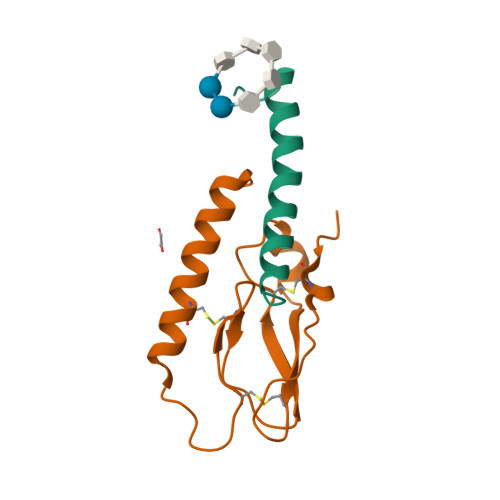1. Boer GA, Hunt JE, Gabe MBN, Windeløv JA, Sparre-Ulrich AH, Hartmann B, Holst JJ, Rosenkilde MM. (2022) Glucose-dependent insulinotropic polypeptide receptor antagonist treatment causes a reduction in weight gain in ovariectomised high fat diet-fed mice.
Br J Pharmacol, 179 (18): 4486-4499.
[PMID:35710141]
2. Bollag RJ, Zhong Q, Phillips P, Min L, Zhong L, Cameron R, Mulloy AL, Rasmussen H, Qin F, Ding KH, Isales CM. (2000) Osteoblast-derived cells express functional glucose-dependent insulinotropic peptide receptors.
Endocrinology, 141: 1228-1235.
[PMID:10698200]
3. Coskun T, Sloop KW, Loghin C, Alsina-Fernandez J, Urva S, Bokvist KB, Cui X, Briere DA, Cabrera O, Roell WC et al.. (2018) LY3298176, a novel dual GIP and GLP-1 receptor agonist for the treatment of type 2 diabetes mellitus: From discovery to clinical proof of concept.
Mol Metab, 18: 3-14.
[PMID:30473097]
4. Coskun T, Urva S, Roell WC, Qu H, Loghin C, Moyers JS, O'Farrell LS, Briere DA, Sloop KW, Thomas MK et al.. (2022) LY3437943, a novel triple glucagon, GIP, and GLP-1 receptor agonist for glycemic control and weight loss: From discovery to clinical proof of concept.
Cell Metab, 34 (9): 1234-1247.e9.
[PMID:35985340]
5. Deacon CF, Plamboeck A, Rosenkilde MM, de Heer J, Holst JJ. (2006) GIP-(3-42) does not antagonize insulinotropic effects of GIP at physiological concentrations.
Am J Physiol Endocrinol Metab, 291 (3): E468-75.
[PMID:16608883]
6. Ehses JA, Lee SS, Pederson RA, McIntosh CH. (2001) A new pathway for glucose-dependent insulinotropic polypeptide (GIP) receptor signaling: evidence for the involvement of phospholipase A2 in GIP-stimulated insulin secretion.
J Biol Chem, 276 (26): 23667-73.
[PMID:11323439]
7. Gallwitz B, Witt M, Morys-Wortmann C, Fölsch UR, Schmidt WE. (1996) GLP-1/GIP chimeric peptides define the structural requirements for specific ligand-receptor interaction of GLP-1.
Regul Pept, 63 (1): 17-22.
[PMID:8795084]
8. Gault VA, O'Harte FP, Harriott P, Mooney MH, Green BD, Flatt PR. (2003) Effects of the novel (Pro3)GIP antagonist and exendin(9-39)amide on GIP- and GLP-1-induced cyclic AMP generation, insulin secretion and postprandial insulin release in obese diabetic (ob/ob) mice: evidence that GIP is the major physiological incretin.
Diabetologia, 46 (2): 222-30.
[PMID:12627321]
9. Gelling RW, Coy DH, Pederson RA, Wheeler MB, Hinke S, Kwan T, McIntosh CH. (1997) GIP(6-30amide) contains the high affinity binding region of GIP and is a potent inhibitor of GIP1-42 action in vitro.
Regul Pept, 69 (3): 151-4.
[PMID:9226399]
10. Hansen LS, Sparre-Ulrich AH, Christensen M, Knop FK, Hartmann B, Holst JJ, Rosenkilde MM. (2016) N-terminally and C-terminally truncated forms of glucose-dependent insulinotropic polypeptide are high-affinity competitive antagonists of the human GIP receptor.
Br J Pharmacol, 173 (5): 826-38.
[PMID:26572091]
11. McIntosh CH, Bremsak I, Lynn FC, Gill R, Hinke SA, Gelling R, Nian C, McKnight G, Jaspers S, Pederson RA. (1999) Glucose-dependent insulinotropic polypeptide stimulation of lipolysis in differentiated 3T3-L1 cells: wortmannin-sensitive inhibition by insulin.
Endocrinology, 140 (1): 398-404.
[PMID:9886851]
12. Miyawaki K, Yamada Y, Yano H, Niwa H, Ban N, Ihara Y, Kubota A, Fujimoto S, Kajikawa M, Kuroe A et al.. (1999) Glucose intolerance caused by a defect in the entero-insular axis: a study in gastric inhibitory polypeptide receptor knockout mice.
Proc Natl Acad Sci USA, 96 (26): 14843-7.
[PMID:10611300]
13. Parthier C, Kleinschmidt M, Neumann P, Rudolph R, Manhart S, Schlenzig D, Fanghänel J, Rahfeld JU, Demuth HU, Stubbs MT. (2007) Crystal structure of the incretin-bound extracellular domain of a G protein-coupled receptor.
Proc Natl Acad Sci USA, 104 (35): 13942-7.
[PMID:17715056]
14. Preitner F, Ibberson M, Franklin I, Binnert C, Pende M, Gjinovci A, Hansotia T, Drucker DJ, Wollheim C, Burcelin R et al.. (2004) Gluco-incretins control insulin secretion at multiple levels as revealed in mice lacking GLP-1 and GIP receptors.
J Clin Invest, 113 (4): 635-45.
[PMID:14966573]
15. Trümper A, Trümper K, Trusheim H, Arnold R, Göke B, Hörsch D. (2001) Glucose-dependent insulinotropic polypeptide is a growth factor for beta (INS-1) cells by pleiotropic signaling.
Mol Endocrinol, 15 (9): 1559-70.
[PMID:11518806]
16. Tseng CC, Kieffer TJ, Jarboe LA, Usdin TB, Wolfe MM. (1996) Postprandial stimulation of insulin release by glucose-dependent insulinotropic polypeptide (GIP). Effect of a specific glucose-dependent insulinotropic polypeptide receptor antagonist in the rat.
J Clin Invest, 98 (11): 2440-5.
[PMID:8958204]
17. Tseng CC, Zhang XY, Wolfe MM. (1999) Effect of GIP and GLP-1 antagonists on insulin release in the rat.
Am J Physiol, 276 (6): E1049-54.
[PMID:10362617]
18. Usdin TB, Bonner TI. (1993) Gastric inhibitory polypeptide receptor, a member of the secretin- vasoactive intestinal peptide receptor family, is widely distributed in peripheral organs and the brain.
Endocrinology, 133: 2861-2870.
[PMID:8243312]
19. Véniant MM, Lu SC, Atangan L, Komorowski R, Stanislaus S, Cheng Y, Wu B, Falsey JR, Hager T, Thomas VA et al.. (2024) A GIPR antagonist conjugated to GLP-1 analogues promotes weight loss with improved metabolic parameters in preclinical and phase 1 settings.
Nat Metab, 6 (2): 290-303.
[PMID:38316982]
20. Volz A, Göke R, Lankat-Buttgereit B, Fehmann HC, Bode HP, Göke B. (1995) Molecular cloning, functional expression, and signal transduction of the GIP-receptor cloned from a human insulinoma.
FEBS Lett, 373 (1): 23-9.
[PMID:7589426]
21. Wheeler MB, Gelling RW, McIntosh CH, Georgiou J, Brown JC, Pederson RA. (1995) Functional expression of the rat pancreatic islet glucose-dependent insulinotropic polypeptide receptor: ligand binding and intracellular signaling properties.
Endocrinology, 136 (10): 4629-39.
[PMID:7664683]
22. Xiong Y, Guo J, Candelore MR, Liang R, Miller C, Dallas-Yang Q, Jiang G, McCann PE, Qureshi SA, Tong X et al.. (2012) Discovery of a novel glucagon receptor antagonist N-[(4-{(1S)-1-[3-(3, 5-dichlorophenyl)-5-(6-methoxynaphthalen-2-yl)-1H-pyrazol-1-yl]ethyl}phenyl)carbonyl]-β-alanine (MK-0893) for the treatment of type II diabetes.
J Med Chem, 55 (13): 6137-48.
[PMID:22708876]
23. Zhong Q, Bollag RJ, Dransfield DT, Gasalla-Herraiz J, Ding KH, Min L, Isales CM. (2000) Glucose-dependent insulinotropic peptide signaling pathways in endothelial cells.
Peptides, 21 (9): 1427-32.
[PMID:11072131]




























